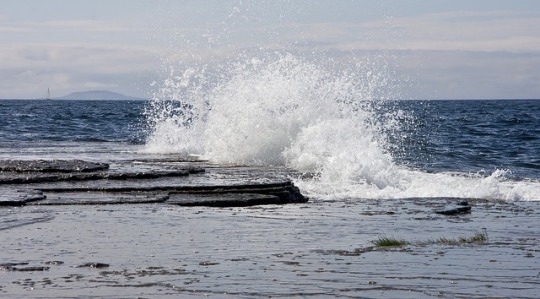Don't wanna be here? Send us removal request.
Text
"Sweden's Seaside Gems: Hidden Beaches and Unspoiled Nature"
Sweden is a country that's famous for its forests, lakes, and mountains, but did you know that it's also home to some of the most beautiful beaches in Europe? From the Baltic Sea in the east to the North Sea in the west, Sweden boasts over 2,000 miles of coastline, dotted with picturesque beaches that offer everything from golden sands to rocky cliffs.

Whether you're a sun worshipper, a swimmer, or a nature lover, there's a beach in Sweden that's perfect for you. Sweden's beaches offer something for everyone.
Skanör Beach:
located in the southern region of Skåne, Skanör Beach is a long, wide stretch of sand that's popular with both locals and tourists. With crystal-clear waters and plenty of amenities, additionally it includes restaurants, cafes, and changing rooms, it's the perfect place to spend a sunny day by the sea.
Falsterbo Beach:
adjacent to Skanör Beach, Falsterbo Beach is another stunning spot that known for its soft sands and clear waters. Here, you'll find plenty of opportunities for swimming, sunbathing, and beach games, as well as a picturesque lighthouse that's perfect for photo ops.
Tylösand Beach:
located on the west coast of Sweden near the town of Halmstad, Tylösand Beach is one of the country's most popular seaside destinations. With a wide range of activities on offer, from beach volleyball and surfing to kiteboarding and windsurfing, it is also the ideal spot for adventure seekers and water sports enthusiasts.
Sandhammaren Beach:
Situated in the southeast of Sweden near the town of Ystad, Sandhammaren Beach is a long, sandy expanse that surrounded by sand dunes and rolling hills. However, with a relaxed, laid-back vibe, it's the perfect place to escape the crowds and enjoy some peace and quiet.
Öland Island Beaches
located off the coast of southeastern Sweden, Öland Island is home to some of the country's most picturesque beaches. However, from the rocky cliffs and turquoise waters of Ekerum Bay to the soft sands and shallow waters of Böda Beach, there's something for everyone on this idyllic island.
Stora Sandö Beach
located in the northern region of Västernorrland, Stora Sandö Beach is a hidden gem that often overlooked by tourists. However, with its rugged coastline and unspoiled natural beauty, it's the perfect place to get away from it all and enjoy some peace and quiet by the sea.
Rörbäcksnäs Beach
It is situated in the remote wilderness of northern Sweden. Rörbäcksnäs Beach is a truly unique destination that's perfect for those looking to escape the crowds and experience the great outdoors. However, with its pristine wilderness and crystal-clear waters, it's the perfect place to hike, swim, and explore.
Umeå Beach
It is located on the east coast of Sweden near the town of Umeå. Umeå Beach is a popular destination for locals and tourists alike. However, with its soft sands, clear waters, and abundance of activities, including beach volleyball, kiteboarding, and fishing. It's the perfect place to spend a summer day by the sea.
Hovs Hallar Beach
located in southwestern Sweden near the town of Båstad, Hovs Hallar Beach is a rugged, rocky stretch of coastline that's perfect for exploring. With its dramatic cliffs and crashing waves, it's the ideal spot for photographers and nature enthusiasts.
Gotland Island Beaches
It is located off the coast of southeastern Sweden. Gotland Island is home to some of the country's most stunning beaches. From the secluded coves and hidden bays of Fårö Island to the Tofta Beach, there's no shortage of natural beauty.
Conclusion:
In conclusion, No matter which of these beaches you choose to visit. You're sure to be struck by the natural beauty and stunning scenery that Sweden has to offer. Moreover, with its unique mix of rugged wilderness and idyllic seaside towns, it's the perfect destination for those looking to get away from it all and experience the great outdoors.
1 note
·
View note
Text
Blue Lagoon Santorini Beaches: A Must-Visit Destination in Greece
Santorini, one of the most beautiful and popular islands in Greece. It known for its picturesque landscapes, stunning sunsets, and amazing beaches. Among these beaches, the Blue Lagoon Santorini is a must-visit destination. If you are looking to experience the best of the island. With its crystal-clear waters and striking volcanic rock formations, the Blue Lagoon Santorini beaches are a true natural wonder that should not be missed.

The Blue Lagoon Santorini is a series of small, secluded beaches located on the eastern coast of the island. The beaches are named after the lagoon-like formation created by the volcanic rocks and the crystal-clear waters of the Aegean Sea. The Blue Lagoon Santorini beaches are popular with both tourists and locals, offering a range of activities and stunning views of the surrounding cliffs and hillsides.
How to get to the Blue Lagoon Santorini beaches:
The Blue Lagoon Santorini beaches are located on the eastern coast of the island, near the town of Oia. The easiest way to get here is by car or taxi, which can be hired from any major town on the island. Alternatively, visitors can take a boat tour of the area, which is a great way to see the beaches from the water and explore the nearby caves and rock formations.
Activities at the Blue Lagoon Santorini beaches:
The Blue Lagoon Santorini beaches offer a range of activities for visitors of all ages. However, swimming in the crystal-clear waters is a must-do activity, with the lagoon-like formation providing a safe and sheltered area for swimming and snorkeling. For those looking for a more adventurous experience, the nearby cliffs offer great opportunities for cliff jumping and diving.
In addition to swimming and diving, visitors can also explore the nearby caves and rock formations. As the rock formations are a popular spot for photographers and nature lovers. There are also several restaurants and bars located on the beaches, offering delicious local cuisine and refreshing drinks.
Best time to visit the Blue Lagoon Santorini beaches:
The Blue Lagoon Santorini beaches can visit throughout the year, although the best time to visit is during the summer months of June to September. During this time, the weather is warm and sunny, and the water temperature is perfect for swimming and other water activities.
Tips for visiting the Blue Lagoon Santorini beaches:
When visiting the Blue Lagoon Santorini beaches, it is important to bring plenty of sunscreen and a hat. As the sun can be strong in the summer months. Visitors should also bring appropriate footwear for exploring the nearby rocks and cliffs. It is also a good idea to bring a camera to capture the stunning views and natural beauty of the beaches.
Conclusion:
In conclusion, the Beaches with blue waters in Santorini are a must-visit destination for anyone traveling to the island of Santorini. With its crystal-clear waters, stunning volcanic rock formations, and range of activities, the Blue Lagoon Santorini beaches offer something for everyone. Whether you are looking to relax on the beach, explore the nearby caves and cliffs, or simply enjoy the beautiful scenery, the Blue Lagoon Santorini beaches are sure to impress. So, don't miss out on this amazing natural wonder and plan your visit today.
0 notes
Text
"Best Time to Visit Dallas: When to Experience the Best of Dallas"
Are you planning a trip to Dallas? Choosing the best time to visit can make a big difference in your experience. Dallas is a city that offers something for everyone. Whether you're interested in arts and culture, sports, or just exploring a new city. In this article, we'll take a closer look at the best time to visit Dallas and what you can expect during different seasons.

Best Time to Visit Dallas
The best time to visit Dallas is between September and November or March and May. During these months, the weather is mild, and you'll avoid the sweltering heat of summer and the chilly winter temperatures. These months also coincide with some of the most popular festivals and events in Dallas, such as the State Fair of Texas in September and the Dallas Arts Festival in April.
Spring in Dallas:
Spring is a popular time to visit Dallas, with temperatures ranging from the mid-60s to mid-70s Fahrenheit. This is the perfect time to enjoy outdoor activities like hiking, biking, and exploring the city's many parks and gardens. You'll also find many events and festivals taking place during this time, such as the Dallas Blooms festival at the Dallas Arboretum and Botanical Garden.
Summer in Dallas:
Summer in Dallas can be quite hot, with temperatures often reaching into the 90s Fahrenheit. However, this is also the time when many popular events take place, such as the Independence Day Parade and the Dallas Margarita Festival. If you don't mind the heat, summer can be a great time to visit Dallas and take advantage of outdoor activities like swimming, hiking, and exploring the city.
Fall in Dallas:
Fall is another popular time to visit Dallas, with temperatures ranging from the mid-60s to mid-70s Fahrenheit. This is the time when many of the city's biggest festivals and events take place, such as the State Fair of Texas and the Texas Book Festival. If you're a sports fan, fall is also a great time to visit Dallas and catch a Cowboys or Mavericks game.
Winter in Dallas:
Winter in Dallas can be chilly, with temperatures often dipping into the 30s and 40s Fahrenheit. However, this is also the time when you'll find many holiday events and attractions, such as the Dallas Holiday Parade and the Dallas Zoo Lights. If you're a fan of ice skating or skiing, you can also take a short drive to nearby locations like the Galleria Dallas Ice Skating Center or the Snowy Range Ski Area.
Conclusion:
Dallas is a city that offers something for everyone, no matter what time of year you visit. However, by choosing the great time to visit Dallas, you can maximize your experience and take advantage of everything the city has to offer. Whether you're interested in outdoor activities, festivals, or sports, there's a season that's perfect for you. So, pack your bags and get.
0 notes
Text
CITRUS FAMILY
Where do citrus fruits come from?
All of the citrus fruits are from the family Rutaceae. This family is also known as the rue family and contains flowering plants that generally have a strong scent. The genus Citrus includes oranges, grapefruits, limes and lemons. These fruits have been cultivated since ancient times. They have probably originated from Australia, New Caledonia and New Guinea, although some research points to them originating in Southeast Asia. Many of the species are hybrids and there is speculation that even the wild true-breeding species are actually hybrids originally.
What do citrus fruits do?
All of the citrus fruits are noted for their fragrance. This is due to limonoids and flavonoids (both of which have strong antioxidant and antibacterial properties). They can help prevent kidney stones, as they contain high levels of citrate. Lemons are the highest, drinking diluted lemon juice daily has been shown to decrease kidney stone formation.
The vitamin C content of citrus fruits is legendary, and regular consumption has been found to decrease your cardiovascular and heart disease risks, whilst increasing life expectancy. Vitamin C is also a natural anti-histamine, preventing histamine release and aiding in its detoxification. Vitamin C functions as an antioxidant, reducing oxidative stress.
How do I use citrus fruits?
Use the peel! It’s full of antioxidants and can help fight free radicals, balance blood sugar levels and support thyroid health. You can buy candied peel for desserts here.
Juice, have a look at our smoothie and juice recipes.
Mix with water, a slice or 2 of a citrus fruit in hot water first thing in the morning will help to alkalise your system and aid in cleansing.
What fruits do Real Foods sell from the citrus family?

Lemons are probably a hybrid between a bitter orange (C. Aurantium) and a citron (C. Medica). Although it could be a hybrid involving limes! They contain high amounts of citric acid, around 5-6% of total weight. Initially discovered in India, lemons were avilable during the Roman Empire's heydays but were not widely cultivated until the Arabs introduced them into Italy in the 8th century. Colombus took them to America and it was then that their amazing effects on scurvy were noticed. They are highly valued for their juice and high vitamin C content.
Limes - C. Aurantifolia are so called because they have long been confused with lemons. The name is derived from ‘limun’. The 2 most popularly cultivated limes are the Mexican or key Lime and the Persian lime. Limes were unknown in Europe before the crusaders and were probably imported from Palestine after Arabs had introduced them there. Their incredible flavour and high essential oil content is used widely in cooking and is popular for marinades.

Tangerines – C. Tangerina is probably derived from C. Oculata. Less sour and sweeter than oranges, the name is derived from Tangiers which grew them widely at one time. The red-orange skin is usually what separates them from mandarins.
Satsumas – C. Unshiu are probably of Japanese origin and are very easy to peel. Sweet, their nickname the “Christmas orange” is because they are very popular as Christmas treat in the U.K.
Sweet oranges are known as Citrus Sinensis and are a hybrid between a pomelo (C. grandi s or C. maxima) and a mandarin (C. reticulata). There is no history of the orange being grown in the wild and it’s thought to have been selected in China or northern India from their cultivation of mandarins and pomelos. Oranges have been grown from at least 2500 B.C.E in China.


Bergamot (Citrus Bergamia) are a hybrid between lemons and oranges (it’s why they’re sometimes called orange bergamot and others call them lemon bergamots). They are relatives of sour oranges and are famously unpalatable. Similar to Seville in the sense they are prized for their zest, their flavour and pith for marmalade making and their scent. They do not taste very nice however! Bergamots are only available occasionally through the year.
2 notes
·
View notes